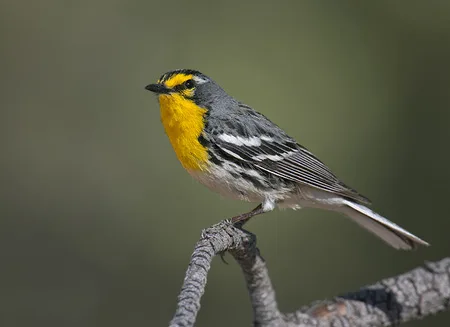
Graces Warbler
[order] PASSERIFORMES | [family] Parulidae | [latin] Dendroica graciae | [UK] Graces Warbler | [FR] Sylvette a dos gris | [DE] Arizona-Waldsanger | [ES] Reinita de Grace | [NL] Grace’s Zanger
Subspecies
| Genus | Species | subspecies | Breeding Range | Breeding Range 2 | Non Breeding Range |
| Dendroica | graciae | NA | sw USA | n, c MA | |
| Dendroica | graciae | decora | |||
| Dendroica | graciae | graciae | |||
| Dendroica | graciae | remota | |||
| Dendroica | graciae | yaegeri |
Physical charateristics
Gray-backed, with a yellow throat, two wing bars, yellowish eyebrow stripe, stripes on sides. Resembles Yellow-throated Warbler, which has a white patch behind the ear.
Listen to the sound of Graces Warbler
[audio:http://www.aviflevoland.nl/sounddb/G/Graces Warbler.mp3]
Copyright remark: Most sounds derived from xeno-canto
| wingspan min.: | 20 | cm | wingspan max.: | 21 | cm |
| size min.: | 12 | cm | size max.: | 13 | cm |
| incubation min.: | 11 | days | incubation max.: | 12 | days |
| fledging min.: | 0 | days | fledging max.: | 0 | days |
| broods: | 1 | eggs min.: | 3 | ||
| eggs max.: | 4 |
Range
North America : Southwest USA. Scattered populations in the mountains from southern Nevada, southern Utah, and southwestern Colorado, south through western and central Mexico to Nicaragua.
Habitat
Pine-oak forests of mountains. During the breeding season, found mainly in the tops of pines, sometimes also in spruce, fir, and oak thickets from 6,000-
8,000′ elevation in the mountains of the Southwest. In winter in Mexico, inhabits pine-oak woods in the mountains.
8,000′ elevation in the mountains of the Southwest. In winter in Mexico, inhabits pine-oak woods in the mountains.
Reproduction
Details of breeding behavior are not well known. In the Southwest, arrives on breeding grounds mostly in early April. Males defend nesting territories by singing.
Nest: Placed on a horizontal branch or in the top crown of tree, usually pine, sometimes fir, 20-
60′ above the ground. Nest (built by female) is a tightly constructed open cup made of plant fibers, oak catkins, plant down, and webs of spiders and caterpillars; lined with animal hair and feathers. Nest is often we
ll hidden among a cluster of pine needles.
Eggs: 3-4. Creamy white, spotted with brown around larger end. Details and timing of incubation are not well known.
Young: Nestlings are fed by female, probably by male as well. Age at which young leave the nest is not well known. Normally 2 broods per year.
Nest: Placed on a horizontal branch or in the top crown of tree, usually pine, sometimes fir, 20-
60′ above the ground. Nest (built by female) is a tightly constructed open cup made of plant fibers, oak catkins, plant down, and webs of spiders and caterpillars; lined with animal hair and feathers. Nest is often we
ll hidden among a cluster of pine needles.
Eggs: 3-4. Creamy white, spotted with brown around larger end. Details and timing of incubation are not well known.
Young: Nestlings are fed by female, probably by male as well. Age at which young leave the nest is not well known. Normally 2 broods per year.
Feeding habits
Presumably mostly or entirely insects. Details of diet are not well known; undoubtedly eats mostly insects, as other warblers do.
Behavior: During the breeding season, often forages by flying
out from the treetops to catch insects in midair. Also searches among branches and twigs and hovers briefly while picking insects from foliage, spending most of its time in the tops of the taller pine trees. During migration and winter, forages in mixed
flocks with other birds.
Behavior: During the breeding season, often forages by flying
out from the treetops to catch insects in midair. Also searches among branches and twigs and hovers briefly while picking insects from foliage, spending most of its time in the tops of the taller pine trees. During migration and winter, forages in mixed
flocks with other birds.
Conservation
This species has an extremely large range, and hence does not approach the thresholds for Vulnerable under the range size criterion (Extent of Occurrence <20,000 km2 combined with a declining or fluctuating range size, habitat extent/quality, or population size and a small number of locations or severe fragmentation). Despite the fact that the population trend appears to be decreasing, the decline is not believed to be sufficiently rapid to approach the thresholds for Vulnerable under the population trend criterion (>30% decline over ten years or three generations). The population size is extremely large, and hence does not approach the thresholds for Vulnerable under the population size criterion (<10,000 mature individuals with a continuing decline estimated to be >10% in ten years or three generations, or with a specified population structure). For these reasons the species is evaluated as Least Concern.

Migration
Grace’s Warblers summer in the south-western United States and northern Mexico and migrate into Central America for the winter, traveling as far south as Nicaragua.
Distribution map

